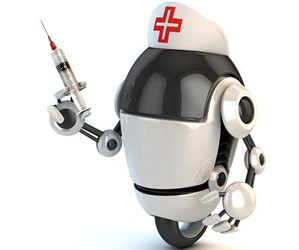Dr. Chatbot Will See You Now! AI In Healthcare
By James Hoshor, Anexinet

What is one key thing all healthcare organizations strive for? Improved patient experience!
An annual Localytics study revealed the average smartphone user has 30 installed apps but regularly uses fewer than five. And nearly one in four (23 percent) stop using an app after opening it just once. What this tells us is businesses must continue to devise and deliver novel approaches to customer engagement.
According to a recent survey by CB Insights, over 550 startups incorporated AI into their solution offerings for 2016. Industries such as healthcare are allocating portions of their annual budgets for implementing chatbots and AI technologies to achieve key business drivers — improving customer experiences and increasing employee productivity. This is literally a big deal. Some of the largest brands (i.e. Bank of America, Facebook, Starbucks, eBay) are all making significant investments in chatbots and AI technologies.
Before I share what all the hype is about with chatbots in healthcare, let’s first make sure we all understand what chatbots are. Simply put, Chatbots are programs a user interacts with via a conversational interface. Instead of clicking buttons to execute the program’s functions, with a chatbot, the user types (or says) a command for the program to execute. I’m sure you’ve already used one of these well-known chatbots: Amazon Echo, Google Home, and Apple’s Siri.
But chatbots can’t possibly replace real-live trained and experienced doctors, right? Or can they?
For the past decade robots have been performing jobs once exclusive to humans, from manufacturing cars to filling warehouse orders. As artificial intelligence and neural networks continue to evolve and perfect their interpersonal communication skills chatbots and AI technology will become more commonplace, even in healthcare. In the near future, instead of consulting a doctor for a diagnosis, you might just interface with an AI chatbot in a mobile app.
Can you imagine what this might look like?
Me: Hello “chatbots.”
Chatbot: Hi James, how can I help you?
Me: I have a fever, headache and the chills.
Chatbot: Your smartwatch reports a temperature of 101 F and pulse and blood pressure readings within the range of normal. How long have you had the headache?
Me: On and off for the past couple days.
Chatbot: Do you have any other symptoms?
Me: No.
Chatbot: You reported the same symptoms last week. I recommend you see your doctor. Let’s go ahead and schedule an appointment.
This is no longer the stuff of science fiction. Mobile apps like Your.Md already incorporate chatbots and AI to help consumers find local specialists, ask health-related questions and even check their symptoms. Earlier this year, the UK’s National Health Service launched a trial with Babylon Health, a startup developing an AI chatbot.
The role of chatbots in healthcare is to help free-up valuable physician-time by reducing or eliminating unnecessary doctor’s appointments. With costs increasing daily, healthcare organizations are looking for ways to keep them down while improving the patient experience. Not to mention a global shortage of healthcare professionals makes it increasingly necessary for us to augment care with technology in order to allow doctors to focus on more critical patient needs.
Let’s face it many of the world’s population have limited access to healthcare, though most have smartphones. If downloading a free mobile healthcare app means the difference between suffering needlessly and getting an accurate diagnosis and a recommended treatment, well what could be more invaluable?
But in order for chatbot/AI adoption to really take off in healthcare we as consumers need to become more comfortable trusting the technology is successful (or even appropriate) for diagnosing health issues. Similarly, healthcare organizations will also need to become comfortable trusting the technology and determine best practices for incorporating chatbots in the delivery of services to patients.
Here are some key chatbot take-a-ways healthcare organizations should consider:
- Healthcare organizations need to develop a strategy for implementing emerging technologies like chatbots and AI. First, define the bot’s scope of knowledge. Remember, in order to deliver great patient experiences chatbots need to be simple and feel natural. An effective chatbot must be available 24/7, understand what patients need, and engage them in conversation while providing responses and guidance to resources, along with personalized, intelligent recommendations.
- Once you have devised a strategy, be sure to leverage leading-edge technologies and machine learning that gets smarter over time as it receives more data through patient interactions. Many chatbot and AI solutions are available today. Be sure to choose one that has the right level of personality, sentiment and that understands context. We recommend a Propelics Proof-of-Concept to identify the best solution to meet your business objectives and ensure the best patient experience.
- Chatbots and AI are only successful if they have access to the right data. Healthcare organizations should possess a large inventory of FAQs based on data from online forms, emails, and call centers. Over time, as more and more patients interact with them, chatbots will become smarter in answering questions and evaluating conversations.
About The Author
James is a Senior Mobile Strategist & Solutions Architect for Propelics, an Anexinet company. He has over 20 years of experience in executive leadership, strategic planning, marketing and business development in information technology. For the past 10 years James has worked with many clients across multiple industries, including financial services, insurance, retail and manufacturing, approach mobile strategically to identify and deliver solutions that result in market differentiating solutions and great user experiences.
